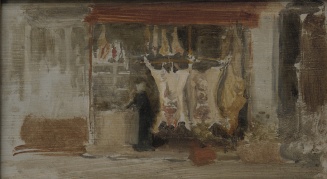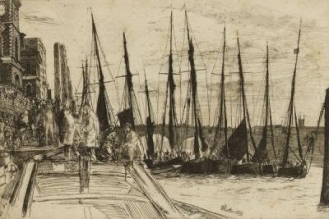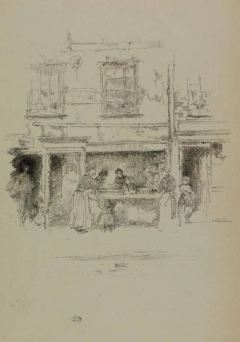
A menu written out by Whistler and dated ‘2 July’ may possibly date from the year 1877. It has a strongly Scottish and American bias, perhaps reflecting Whistler’s nationality (he had American and Scottish grandparents) or that of his guests.
Potage claire à l’estragon –
Sole frite –
Quenelles à la [“]Lindsey Houses” –
Côtelettes de Mouton purée d’Or –
Petits filets de boeuf au four –
Poulet à la Baltimore –
Tomates sur grilles – hominy –
Pouding à l’ecossaise –
Tartelettes à la crème –
Glaces – Café –
This elaborate menu started with a clear soup with tarragon; a fish course of fried sole and ‘quenelles’ a form of fish-cakes followed. There were three ‘removes’ for the meat course, mutton cutlets with a golden purée (perhaps carrots), oven-baked beef filets and Baltimore chicken with grilled tomatoes and hominy. This was a very substantial meal, held down firmly by a rich desert, a Scottish pudding (perhaps a boiled pudding), and relatively lighter (but still rich) cream tartlets, and finally ices and coffee. The fish ‘a la Lindsey Houses’ were a special dish associated with Whistler’s house, or rather his cook. Whistler lived at 2 Lindsey Row (renamed later 96 Cheyne Walk) from 1868 until June 1878 and Mrs Cossins was cook there until 1876.

Billingsgate was the principal fishmarket. Whistler’s etching of the market shows the fishing boats moored in the Thames, the stairs down to the water, and sturdy men with canvas sacks on their backs, waiting to unload the fish. From the market, fish was distributed by boxes, carts and barrows throughout the city and country. Maunder’s fish-shop was one of the local Chelsea retailer, based in an old and rickety house that figured in several of Whistler’s drawings and prints.

So, Whistler having written out a menu, after consulting with the cook, and the cook, or the kitchen maid, having bought the necessary ingredients, what happened next? Some idea of how the contemporary kitchen was run can be gleaned from Mrs Beeton’s Book of Household Management. Despite its eccentricities, it was a well-regarded guide to feeding a household by this time. It was published originally by her husband, S. O. Beeton in 24 monthly parts between 1859-1861, and in hard-back form in 1861. As an example of the content, Mrs Beeton lists ingredients available in July – for, in the absence of refrigerators, such items could not be preserved long in the height of summer:
JULY: FISH.–Carp, crayfish, dory, flounders, haddocks, herrings, lobsters,mackerel, mullet, pike, plaice, prawns, salmon, shrimps, soles,sturgeon, tench, thornback. MEAT.–Beef, lamb, mutton, veal, buck venison. POULTRY.–Chickens, ducklings, fowls, green geese, leverets, plovers,pullets, rabbits, turkey poults, wheatears, wild ducks.. VEGETABLES.–Artichokes, asparagus, beans, cabbages, carrots,cauliflowers, celery, cresses, endive, lettuces, mushrooms, onions,pease, radishes, small salading, sea-kale, sprouts, turnips, vegetable marrow,–various herbs. FRUIT.–Apricots, cherries, currants, figs, gooseberries, melons,nectarines, pears, pineapples, plums, raspberries, strawberries, walnuts in high season, and pickled.
Furthermore Mrs Beeton suggests a dinner for six people in July, which has definite overlaps with the menu written by Whistler and prepared in consultation, presumably with his cook, Mrs Cossins. Mrs B’s menu is, however, even more elaborate than Whistler’s. Mrs B’s menu runs as follows:
DINNER FOR 6 PERSONS (July).–
FIRST COURSE. Julienne Soup. Crimped Salmon and Caper Sauce. Whitebait. ENTREES. Croquettes à la Reine. Curried Lobster.
SECOND COURSE. Roast Lamb. Rump of Beef à la Jardinière.
THIRD COURSE. Larded Turkey Poult. Raspberry Cream. Cherry Tart. Custards, in glasses. Gâteaux à la Genévése. Nesselrode Pudding.
DESSERT.
Having set out the menu, and presumably assuming that her reader has a kitchen full of chefs, cooks and kitchen maids, Mrs Beeton proceeds to give advice on how to conduct such basic operations as cooking and serving sole.
‘BOILED OR FRIED SOLE.The usual way of helping this fish is to cut it quite through, bone and all, distributing it in nice and not too large pieces. A moderately-sized sole will be sufficient for three slices; namely, the head, middle, and tail. The guests should be asked which of these they prefer. A small one will only give two slices. If the sole is very large, the upper side may be raised from the bone, and then divided into pieces; and the under side afterwards served in the same way. In helping FILLETED SOLES, one fillet is given to each person. (For mode of serving, see Coloured Plate A.)’
As for the mutton cutlets, as in Whistler’s menu, well, mutton was much more highly regarded than now, when rather old lambs are still sold as lamb! Mutton has a fine and distinctive flavour. We obtain it from a stall selling Galloway meat at Partick farmer’s market, and it is very good! Mrs Beeton describes Mutton as follows:
Mutton is, undoubtedly, the meat most generally used in families; and, both by connoisseurs and medical men, it stands first in favour, whether its the favour, digestible qualifications, or general wholesomeness, be considered. Of all mutton, that furnished by South-Down sheep is the most highly esteemed; it is also the dearest, on account of its scarcity, and the great demand of it. … The London and other markets are chiefly supplied with sheep called half-breeds, which are a cross between the Down and Lincoln or Leicester. These half-breeds make a greater weight of mutton than the true South-Downs, and, for this very desirable qualification, they are preferred by the great sheep-masters. The legs of this mutton range from 7 to 11 lbs. in weight; the shoulders, necks, or loins, about 6 to 9 lbs.; and if care is taken not to purchase it; the shoulders, necks, or loins, about 8 to 9 lbs.; and if care is taken not to purchase it too fat, it will be found the most satisfactory and economical mutton that can be bought.’
AND here are Mrs Beeton’s instructions for mutton chops:
‘ BROILED MUTTON CHOPS. 711. INGREDIENTS.–Loin of mutton, pepper and salt, a small piece of butter. _Mode_.–Cut the chops from a well-hung tender loin of mutton, remove a portion of the fat, and trim them into a nice shape; slightly beat and level them; place the gridiron over a bright clear fire, rub the bars with a little fat, and lay on the chops. Whilst broiling, frequently turn them, and in about 8 minutes they will be done. Season with pepper and salt, dish them on a very hot dish, rub a small piece of butter on each chop, and serve very hot and expeditiously. Time.–About 8 minutes. Average cost, 10d. per lb. Sufficient.–Allow 1 chop to each person.’
COSTS: This is particularly useful, because Mrs Beeton does indicate the price of the meat, 10 pence a pound sterling (12 pence = 1 shilling, 20 shillings = £1). The price, though it may seem modest, mounts up when a party of six is being fed fairly lavishly. An elaborate meal like the one indicated by Whistler’s menu was actually more than he could afford, given his income at the time. In 1877 he was trying to make ends meet by printing and selling his etchings, and sold several impressions of Billingsgate for £2.2.0 each- including one, to Queen Victoria! However, this was not sufficient to fend off bankruptcy. Entertainment expenses contributed to his insolvency in 1878 – and indeed his fishmonger was among the casualties, having been unpaid for several years!
REFERENCES:
Whistler Menu, 2nd July 1877, http://www.whistler.arts.gla.ac.uk/correspondence/ #06925
For all other sources please see the Bibliography.
One thought on “Butcher, Billingsgate and Mrs Beeton”